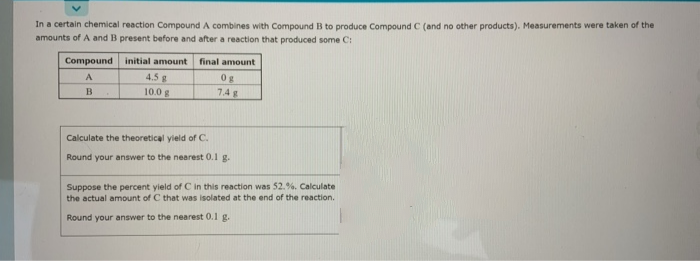In a certain chemical reaction Compound A combines with Compound B to produce Compound C (and no other products). Measurements were taken of the amounts of A and B present before and after a reaction that produced some C: Compound initial amount final amount 4.5 g 10.0 g 0g 748 B Calculate the theoretical yield ofC. Round your answer to the nearest 0.1 g. Suppose the percent yield of C in this reaction was 52.%. Calculate the actual amount of C that was isolated at the end of the reaction. Round your answer to the nearest 0.1 g.
In a certain chemical reaction Compound A combines with Compound B to produce Compound C (and no other products). Measurements were taken of the amounts of A and B present before and after a reaction that produced some C: Compound initial amount final amount 4.5 g 10.0 g 0g 748 B Calculate the theoretical yield ofC. Round your answer to the nearest 0.1 g. Suppose the percent yield of C in this reaction was 52.%. Calculate the actual amount of C that was isolated at the end of the reaction. Round your answer to the nearest 0.1 g.
Principles of Modern Chemistry
8th Edition
ISBN:9781305079113
Author:David W. Oxtoby, H. Pat Gillis, Laurie J. Butler
Publisher:David W. Oxtoby, H. Pat Gillis, Laurie J. Butler
Chapter2: Chemical Formulas, Equations, And Reaction Yields
Section: Chapter Questions
Problem 37P: The iron oxide Fe2O3 reacts with carbon monoxide (CO)to give iron and carbon dioxide:...
Related questions
Question
100%
Please answer

Transcribed Image Text:In a certain chemical reaction Compound A combines with Compound B to produce Compound C (and no other products). Measurements were taken of the
amounts of A and B present before and after a reaction that produced some C:
Compound
initial amount
final amount
4.5 g
10.0 g
A
0g
7.4 g
Calculate the theoretical yield of C.
Round your answer to the nearest 0.1 g.
Suppose the percent yield of C in this reaction was 52.%. Calculate
the actual amount of C that was isolated at the end of the reaction.
Round your answer to the nearest 0.1 g.
Expert Solution
This question has been solved!
Explore an expertly crafted, step-by-step solution for a thorough understanding of key concepts.
This is a popular solution!
Trending now
This is a popular solution!
Step by step
Solved in 3 steps with 1 images

Knowledge Booster
Learn more about
Need a deep-dive on the concept behind this application? Look no further. Learn more about this topic, chemistry and related others by exploring similar questions and additional content below.Recommended textbooks for you

Principles of Modern Chemistry
Chemistry
ISBN:
9781305079113
Author:
David W. Oxtoby, H. Pat Gillis, Laurie J. Butler
Publisher:
Cengage Learning


Chemistry: Matter and Change
Chemistry
ISBN:
9780078746376
Author:
Dinah Zike, Laurel Dingrando, Nicholas Hainen, Cheryl Wistrom
Publisher:
Glencoe/McGraw-Hill School Pub Co

Principles of Modern Chemistry
Chemistry
ISBN:
9781305079113
Author:
David W. Oxtoby, H. Pat Gillis, Laurie J. Butler
Publisher:
Cengage Learning


Chemistry: Matter and Change
Chemistry
ISBN:
9780078746376
Author:
Dinah Zike, Laurel Dingrando, Nicholas Hainen, Cheryl Wistrom
Publisher:
Glencoe/McGraw-Hill School Pub Co


Chemistry
Chemistry
ISBN:
9781305957404
Author:
Steven S. Zumdahl, Susan A. Zumdahl, Donald J. DeCoste
Publisher:
Cengage Learning

Chemistry: An Atoms First Approach
Chemistry
ISBN:
9781305079243
Author:
Steven S. Zumdahl, Susan A. Zumdahl
Publisher:
Cengage Learning